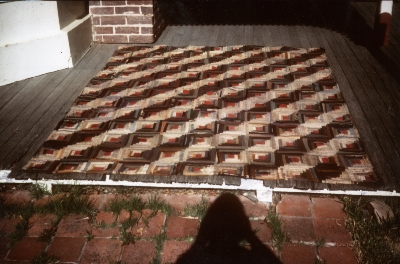Quilt No.183AHS - Arapiles Historical Society Museum
2058 x 1829mm
Made by Mrs Mary Keyte in the Natimuk area (VIC) in the 1880s. Handed down through the Keyte Families, now owned by the Arapiles Historical Society.
Letter from Arapiles Historical Society:
"Mrs Mary Keyte made the quilt from hand me down clothes, and any scraps she was able to collect, mostly used materials. Mrs Mary Keyte passed away on 23-3-19 at the great age of 95 years. A typical English woman she was born at Harbury England 1819, and came to Australia with her husband in 1855, landing at Adelaide, and settling later at McLaren Vale. They came to the Natimuk area in 1872, when most of the early settlers arrived. Her husband conducted a Blacksmith Shop. He died two years after their arrival, so she went to reside with her son Charles, and stayed there until her death. As we can see, Mary was an industrious woman, and could turn her hand to anything., as she would need to be thrifty in that era.
She and her husband are both buried int eh Natimuk Cemetery. Keyte in our area is pronounced at (Keet) Jennifer on TV has a different pronunciation pronounced as (Kyte).
The Keyte families still live in this area. They were highly respected residents, and were ever willing to give a hand where needed.
Mr Keyte had other brotherand sisters, and these folk farmed their land successfully. Mrs Keyte regularly visited Natimuk until 2 or 3 months prior to her death. �"
Related Quilts:
1624 x 1194mm
1860 x 1760mm
2415 x 2110mm
1370 x 1220mm
1740 x 1210mm.








